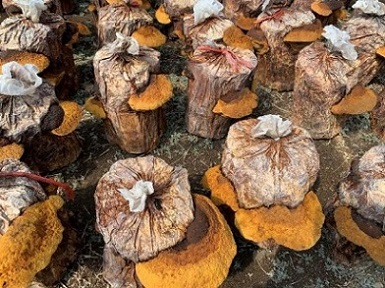Nikhil Prasad Fact checked by:Thailand Medical News Team Jul 08, 2024 9 months, 6 days, 21 hours, 23 minutes ago
Weight Loss News: Introduction: The Rise of Obesity
Obesity is a growing global health issue, with China experiencing a significant increase in obesity rates. Currently, 14.1% of the Chinese population is obese, leading to various health complications such as diabetes, heart disease, and non-alcoholic fatty liver disease. Traditional clinical interventions have had limited success in combating obesity, leading researchers to explore alternative treatments. This
Weight Loss News report, focuses on an exciting new study that investigates the anti-obesity effects of Sanghuangporus vaninii (SPV), a fungus with multiple pharmacological activities, as a potential dietary intervention for obesity.
 The Fungus Sanghuangporus Vaninii As A Potential Natural Solution for Obesity
The Fungus Sanghuangporus Vaninii As A Potential Natural Solution for Obesity
The study was conducted by a team of researchers from several prestigious institutions: Jilin University, China, Changchun University of Science and Technology, China and Guangxi Academy of Agricultural Sciences, China.
Methodology: Experimenting with SPV
To explore the anti-obesity effects of SPV, researchers used a long-term high-fat diet (HFD) to induce obesity in mice. Different doses of SPV and the positive control drug simvastatin (SV) were administered to the mice. The study examined the impact of SPV on weight regulation, serum lipids, adipocyte size, inflammation, and hepatic steatosis (fatty liver disease).
Key Findings: Weight and Lipid Regulation
SPV showed promising results in regulating body weight and serum lipids in the mice. The treatment led to significant decreases in total cholesterol (TC), triglycerides (TG), and low-density lipoprotein cholesterol (LDL-C) levels by 9.72%, 9.29%, and 12.29%, respectively. Conversely, there was a 5.88% increase in high-density lipoprotein cholesterol (HDL-C) levels. These changes indicate that SPV can effectively regulate lipid metabolism, which is crucial in managing obesity.
Reducing Inflammation
Inflammation is a key feature of obesity, often exacerbated by factors such as high levels of tumor necrosis factor-alpha (TNF-α). The study found that SPV treatment significantly reduced levels of inflammatory markers in the liver, including TNF-α, IL-1β, IL-18, and IL-6. By suppressing these inflammatory factors, SPV helps mitigate one of the critical contributors to obesity-related complications.
Improving Liver Health
The liver is a vital organ affected by obesity, often leading to hepatic steatosis. The study found that SPV treatment reduced lipid accumulation and vacuoles in the liver, indicating less fat infiltration. Moreover, levels of liver damage markers ALT and AST were significantly decreased, highlighting SPV's protective effects on liver health.
Gut Microbiota: A Key Player
The gut microbiota plays a crucial role in regulating energy metabolism and inflammation. The study revealed tha
t SPV treatment altered the gut microbiota composition in a beneficial way. It increased the abundance of beneficial bacteria such as Lactobacillus, Clostridium, Bacteroides, Adlercreutzia, and Allobaculum, while reducing harmful bacteria like Anaerotruncus, Ruminococcus, and Oscillospira. These changes in gut microbiota contribute to improved lipid metabolism and reduced inflammation.
Lipid Metabolism: Targeting Sphingomyelin
SPV treatment also influenced lipid metabolism, particularly by reducing levels of sphingomyelin (SM), a precursor to ceramides (Cer). Ceramides are linked to insulin resistance and inflammation, key factors in obesity. By lowering ceramide levels, SPV helps improve insulin sensitivity and reduce inflammatory responses, further supporting its anti-obesity effects.
Mechanism of Action: TLR4/NF-κB Pathway
The study demonstrated that SPV regulates the toll-like receptor (TLR4)/nuclear factor kappa B (NF-κB) signaling pathway, which is involved in inflammation and lipid metabolism. SPV treatment suppressed the expression of TLR4, MyD88, TRAF6, and other related proteins, thereby inhibiting the activation of inflammatory mediators. This mechanism highlights how SPV can effectively reduce inflammation and improve lipid metabolism in obese mice.
Conclusion: A Promising Future for SPV
The findings of this study provide compelling evidence that SPV, a natural fungus, can effectively combat obesity by regulating weight, improving lipid metabolism, reducing inflammation, and protecting liver health. While further research is needed to isolate specific components responsible for these effects, SPV shows great promise as a natural dietary intervention for obesity.
The study findings were published in the peer-reviewed journal Nutrients.
https://www.mdpi.com/2072-6643/16/13/2159
For the latest
Weight Loss News, keep on logging to Thailand Medical News.
Read Also:
https://www.thailandmedical.news/news/move-over-ozempic-and-wegovy-fermented-blackberries-the-new-anti-obesity-and-weight-loss-remedy
https://www.thailandmedical.news/news/weight-loss-news-psyllium-husk-fiber-might-be-better-and-safer-for-diabetes-and-weight-loss-than-overpriced-designers-drugs-like-ozempic-and-wegovy
